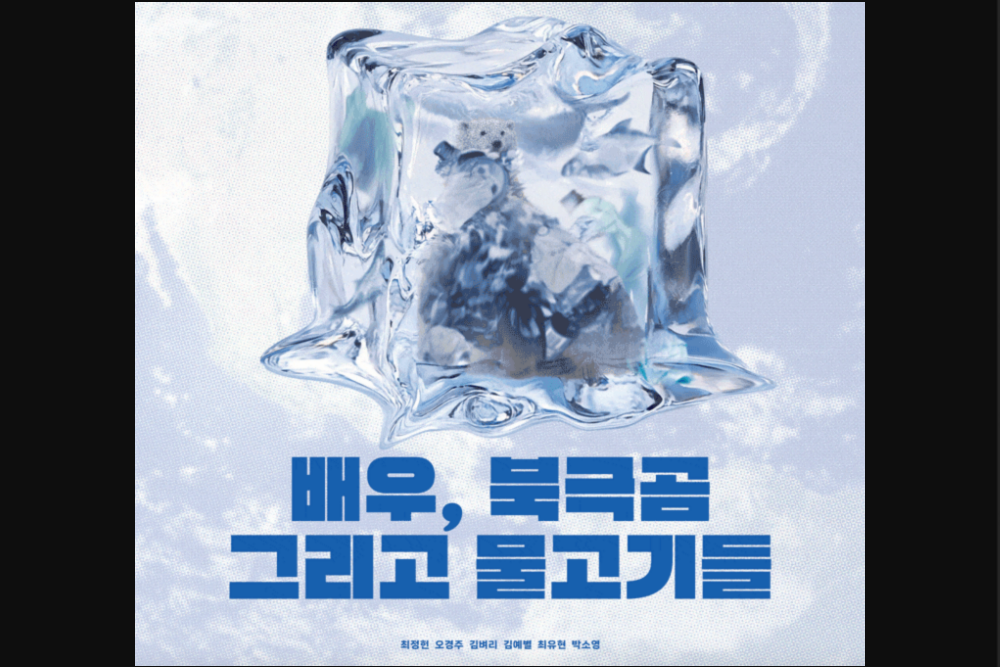Travel in the Climate Crisis Era — still an Unfinished Assignment
Since the end of COVID-19, there has been growing emphasis on the need to transform systems across all areas of human activity to align with the realities of the climate crisis. As a result, discussions around building a sustainable future are unfolding across various sectors — and travel is no exception. Around the world, stakeholders in tourism and public administration are beginning to address climate action through platforms like COP29, where tourism has been officially adopted as part of the climate agenda. A wide range of actors in society are now exploring alternatives to traditional, carbon-intensive modes of travel, seeking new ways to journey that are more in harmony with the planet.
According to a research article published in Nature Communications, the carbon footprint of the travel sector increased at an average annual rate of 3.5% between 2009 and 2019. In 2019, the sector accounted for 5.2 gigatons (Gt) of CO2 equivalent (CO2e), representing 8.8% of global greenhouse gas emissions. This marks an increase of approximately 1.5 Gt CO2e compared to 3.7 Gt CO2e in 2019. The analysis showed that direct emissions amounted to 1.8 Gt CO2e, with the aviation sector responsible for 52% and road transport for 18% of these emissions. Indirect emissions totaled 2.5 Gt CO2e, with utilities contributing 34% and oil production 14%. Emissions from private vehicles accounted for 0.9 Gt CO2e. An earlier 2018 study, involving some of the same researchers, also found that the largest portion (49%) of travel sector emissions came from transportation. Per capita carbon emissions by mode of transport were ranked in the following order: aircraft, automobiles (SUVs > small cars), motorcycles, buses, trains, and ferries.
Focusing specifically on domestic travel, the most commonly used mode of transportation is by car, accounting for an overwhelming 85.8% in 2023. This figure further increased to a provisional 89.1% in the third quarter of 2024. Following cars, the next most frequently used modes were airplanes (4.1%), express/intercity/city buses (3.0%), subways (2.9%), and railways (1.8%), respectively. These findings highlight that within the travel sector, the transportation segment—and particularly carbon emissions from cars—has a significant impact on overall emission trends.
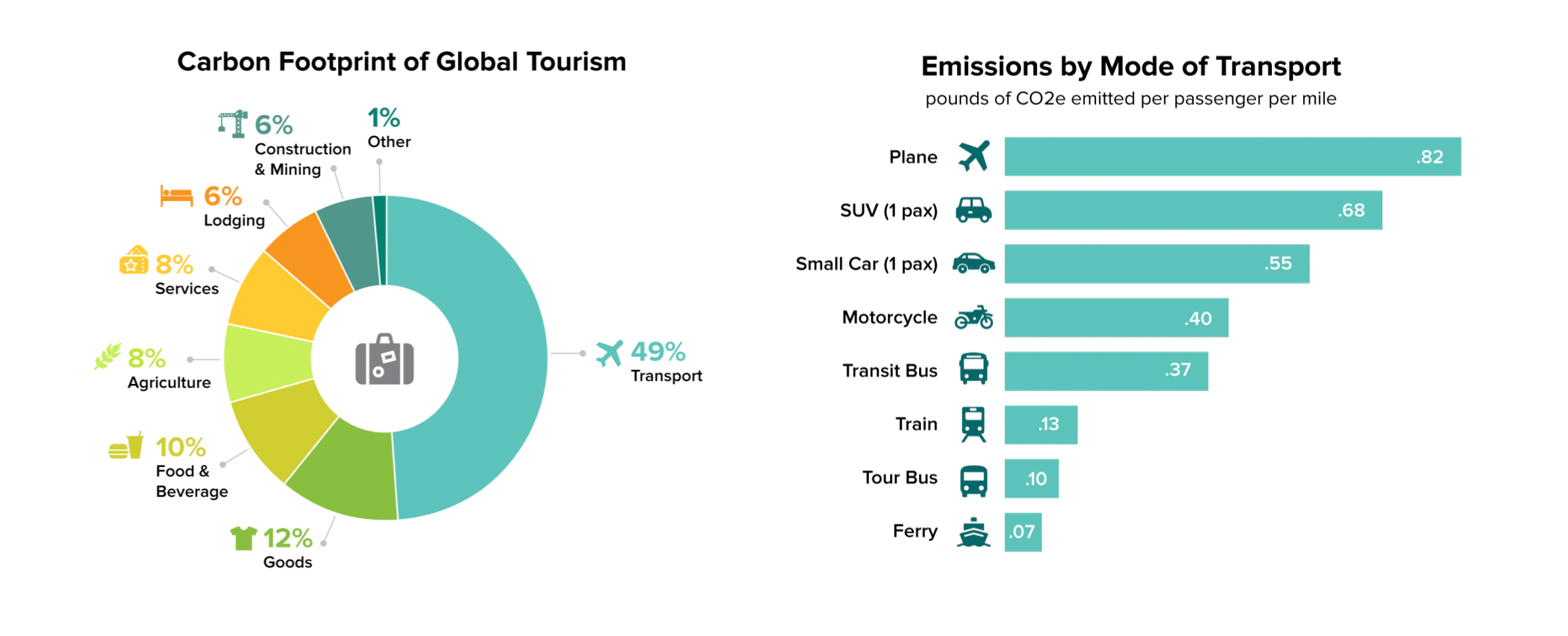
(Source: Sustainable Travel International)
According to Nature Climate Change, global demand for the tourism industry has increased over the past decade, leading not only to carbon emissions but also to social issues such as overtourism. However, efforts to effectively address these challenges remain insufficient. Nevertheless, the world is moving in multiple directions toward carbon neutrality, and even in transportation—which accounts for the largest share of travel-related emissions—there is growing exploration of behavioral changes to reduce emissions. Globally, policies encouraging low-carbon travel are being implemented, and sustainable aviation fuels for airplanes, energy-producing technologies, and electric vehicles on the roads are gradually becoming part of everyday reality. Amid these developments, the bicycle industry and culture—though considered a mode of travel—has seen relatively low utilization and is scarcely reflected in emission statistics. Yet, in the era of climate change, cycling is being repositioned as a promising option. Not only for everyday commuting but also for travel, bicycles are increasingly recognized as a low-carbon transportation choice. To make cycling convenient and enjoyable, both public and private sectors are actively developing infrastructure and content to support this shift.
In South Korea, discussions are underway to review and address barriers to bicycle travel, such as road conditions, connectivity with public transportation, and gaps in legislation. Both public institutions like the Ministry of Culture, Sports and Tourism and the Korea Tourism Organization, as well as private sectors, are actively developing bicycle travel products. Additionally, policies aimed at expanding bicycle demand through shared mobility services and campaigns to promote bicycle culture and improve public awareness are being vigorously pursued.
What is Bicycle Travel and How is it Done?
Before exploring what bicycle travel is, the options emerging as forms of bicycle travel within Korea’s cycling culture, and the social movements aimed not only at reducing carbon emissions through cycling but also at creating a sustainable travel culture, let’s first take a closer look at what bicycle travel actually means.
Bicycle travel can take countless forms depending on who is traveling, what kind of plan is made, how it is arranged, and the method of traveling by bike. Travelers may choose to entrust the entire trip— including accommodation, meals, and routes— to a tour company and travel with a guide, or they may lead and manage the trip themselves. Alternatively, they can independently handle all aspects of their journey while traveling by bicycle. Traditionally, most bicycle travel occurs on roads and infrastructure designed for cycling. In such cases, the travel can take the form of a tour, where time and route are planned in advance, or pottering, where travelers move around more spontaneously, enjoying places they come across by chance. Additionally, bicycle travel can also extend to more adventurous or expedition-style journeys. Moreover, the style of bicycle travel varies widely depending on factors such as travel duration, distance, accommodation arrangements, group size, types of bicycles used, and the degree to which other transport modes like public transit or cars are integrated. Because of this complex mix of conditions and approaches, it is difficult to neatly categorize all the different forms of bicycle travel.
However, if we understand travel as an activity based on moving away from daily life for purposes such as exploration, pleasure, or healing, then why not consider the entire experience of traveling by bicycle—rather than by airplane or car—as bicycle travel? Bicycle travel encompasses not only completing an itinerary by bike but also engaging in various forms of tourism by bicycle. Bicycle travel varies greatly depending on the rider’s skill level and preferred style of travel. It can involve carrying all your luggage on the bike and traveling entirely by bicycle, or it might include using public transportation or cars for convenience without luggage—such as traveling to a destination by other means and then exploring locally by bike. Another form includes transporting luggage separately while covering the travel route solely by bike. All of these are forms of travel centered around the bicycle as the primary mode of transportation. Perhaps it is reasonable to define bicycle travel as any journey where a bicycle is used at least to some extent during the travel process.
WHERE to GO: where should we go traveling by bicycle?
Bicycle travel offers a freedom of movement comparable to that of walking tours. In an era sensitive to carbon emissions, it is a sustainable form of travel that helps reduce emissions in the transportation sector, primarily because it involves a mode of transport that produces no direct carbon emissions 1). So, where and how do people travel by bicycle? Is it only done as nature-based travel? Not at all. Even when considering just bicycle travel within South Korea, travelers can freely plan trips to anywhere their hearts desire, thanks to numerous routes that crisscross or circle through city centers, suburban areas, and across the entire country. Many local governments, including Seoul, have developed regional tourism infrastructure and offer travel routes, while the national government also provides a variety of bicycle travel courses.
For example, since December 2015, Seoul has established a bicycle road network of approximately 240 kilometers centered around the Han River. These roads connect areas such as Nanji District, Mapo Bridge, Banpo Bridge, Seongsu Bridge, and Gwangjin Bridge, providing opportunities to expand travel ranges to the satellite cities surrounding Seoul.
In September of this year, the 4,500-kilometer-long “Korea Dullegil” (Korea Trail) was completed after 15 years since its inception in 2009, encircling the entire Korean Peninsula along its edges. Following the completion of the East Coast’s Haeparang Trail, the South Coast’s Namparang Trail, and the West Coast’s Seohaerang Trail between 2016 and 2022, the Peace Trail was finally opened in the demilitarized zone (DMZ) area, the border region. The Korea Dullegil includes 60 “Bicycle Free Travel Courses.” Unlike the “30 Beautiful Bicycle Travel Routes” established in 2018, which focused mainly on enjoying scenic rides along riversides, these courses pass through 10 metropolitan municipalities and 78 local governments, enabling travelers to explore various parts of the country. Travelers can enjoy cycling along national routes established along the four major rivers—the Han, Nakdong, Geum, and Yeongsan Rivers—as well as nearby tourist spots and attractions. The lengths of these courses vary from 10 km to 50 km, allowing travelers to choose according to their preferences. The 60 Bicycle Free Travel Courses associated with Korea Dullegil underwent on-site inspections during the Low Carbon Travel Week2) and will be featured in the themed section of the “Korea Travel Online” website in January 2025. This marks a meaningful effort by a government-affiliated travel institution, which had previously discontinued a bicycle route information service3), to redevelop and share bicycle travel culture content, thereby fostering the growth of bicycle travel culture once again.
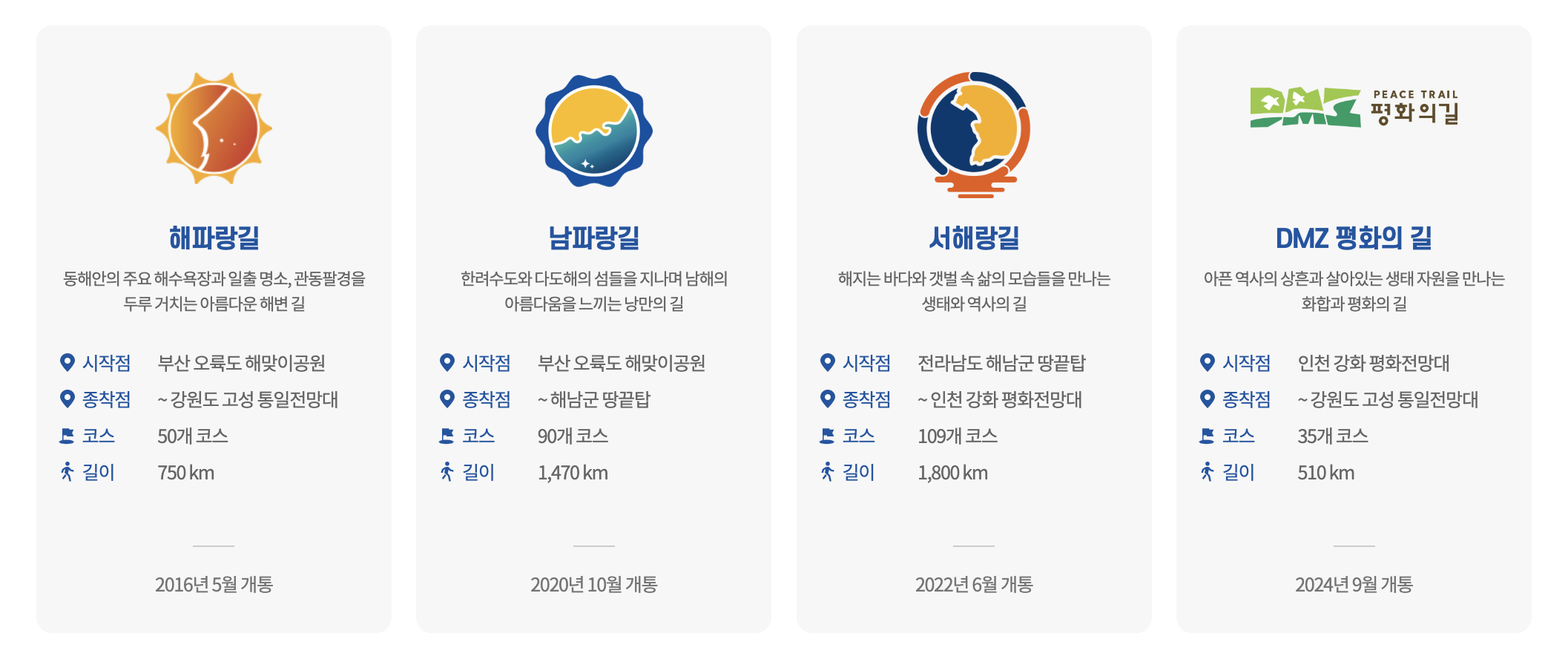
<Figure 2> Four Sections of the Korea Dullegil: Haeparang Trail, Namparang Trail, Seohaerang Trail, and DMZ Peace Trail
(Source: Durunubi)
Since June, the Ministry of Culture, Sports and Tourism has been developing travel products that not only promote tourism but also help revitalize local economies by encouraging travel along “historic site bicycle routes” and related areas. Following routes in Chuncheon, Gangwon Province; Gapyeong and Yangpyeong in Gyeonggi Province; and Jeju Island, the fourth bicycle pilgrimage route was selected in October, covering the Baengmagoji historic site in Cheorwon County, Gangwon Province, and Yeoncheon County in Gyeonggi Province. Meanwhile, attention is also drawn to local governments like Yeoju City, which is aiming to become a bicycle-friendly city by 2025 and is preparing a bicycle travel platform. To provide cyclists with attractions, food, and entertainment, Yeoju plans to utilize existing infrastructure such as Yeoju Station and establish bicycle paths connecting cultural and tourist sites like the Royal Tomb of King Sejong and Silleuksa Temple. They are also planning family-friendly bicycle races linked to festivals and events like the Gangcheon Island Bicycle Travel Festival.
In the private sector, platforms providing information about bicycle travel destinations are also emerging. For example, “A:DBIKE” (Advise + Bike), operated by “Travel Workshop(여행공방)” (which has been running since December 2013), offers a variety of domestic and international travel destinations and routes tailored to different levels of bicycle travel experience. Beyond travel routes, the platform also provides information on luggage storage as well as accommodation and dining options at travel destinations. In particular, to address the lack of transportation options encountered during the development of bicycle travel routes, A:DBIKE partnered with Korail to provide dedicated railcars for transporting bicycles. This collaboration has made it possible to create bicycle travel routes that connect various parts of the country accessible by train. Those planning bicycle trips within Korea can transport their bikes by train and continue their journey upon arrival by using local bike-sharing services—such as Namwon City’s “Bicycle RO”—offered by municipalities.
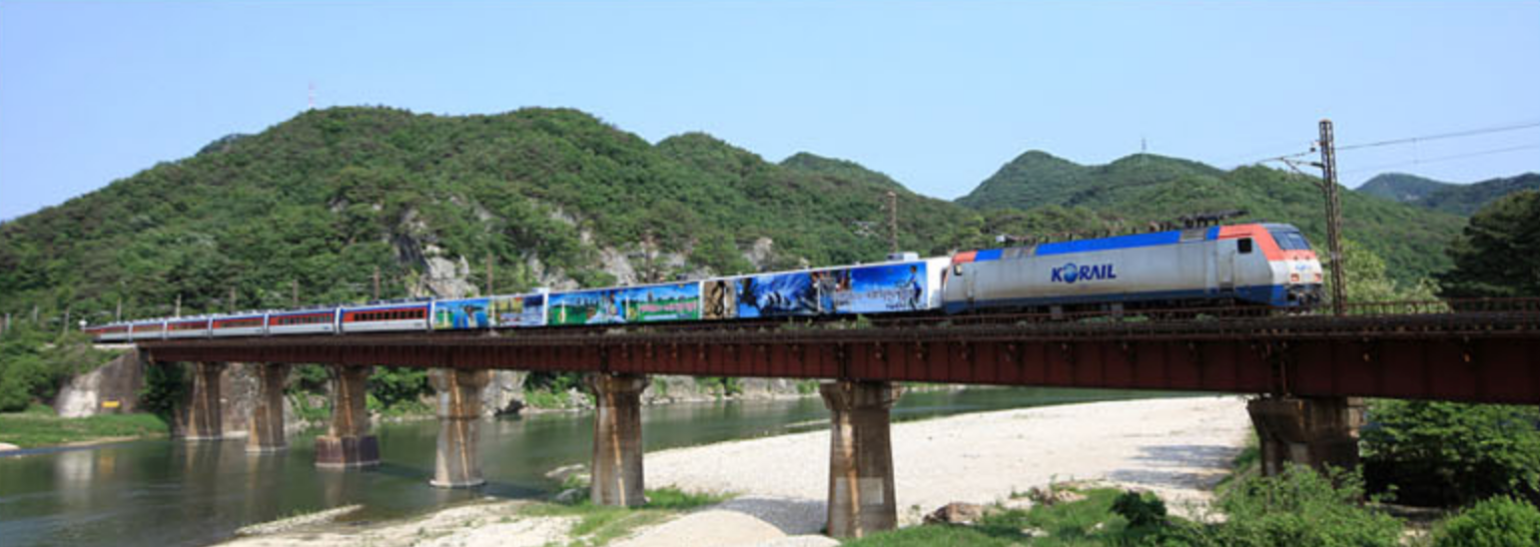
<Figure 3> Ecorail Train Operated by Korail and Travel Workshop
(Source: Travel Workshop)
WIKE (since December 2020), which combines travel and camping, focuses on enabling cyclists to enjoy slow yet sustainable travel. By partnering with domestic campsites, WIKE offers a bicycle travel style that allows travelers to stay in one area, camp, and explore various parts of the local community. Since September 2021, WIKE has been operating a sustainable bicycle travel product called “Riders Camp.” Examples include the “Samyu Trip” (Freedom, Leisure, Reflection) in Namyangju and Yangpyeong, planned with Red House Campsite in 2021 and 2022; the Ganghwa Island Stamp Tour, planned with Yaho Campsite in 2023; and this year’s Haenam Stamp Tour, conducted in collaboration with Haenam County and O’Siano Campsite.
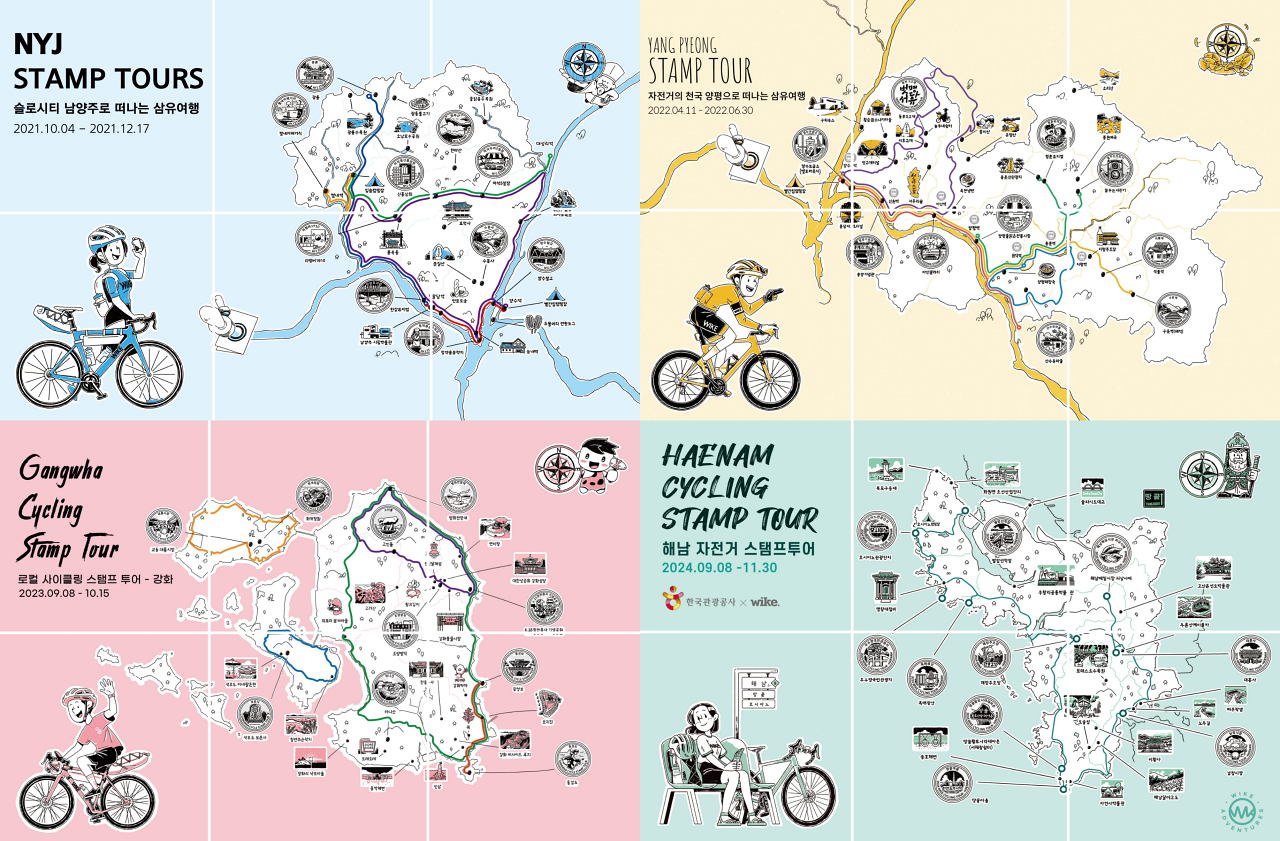
<Figure 4> Domestic Areas Where WIKE’s Stamp Tours Took Place: Namyangju, Yangpyeong, Ganghwa Island, Haenam
(Source: WIKE Official Instagram)
HOW to START: how do you bring a bicycle along? and if you don’t have a bike, how can you go on a bicycle trip?
Whether a trip begins by riding a bicycle or by traveling with a bicycle in tow, bicycle travel always starts with considering the mode of transportation—that is, how to get to the destination. In South Korea, some people travel by private car for their bicycle trips, but many also use public transportation such as subways, city and intercity buses, and express buses. For subways, there are specific rules set by each transit company depending on the subway line (Seoul Subway Lines 1–9, Shinbundang Line, etc.), the day of the week (weekdays, weekends, and holidays), and the type of bicycle (folding or regular). It’s important to check these regulations in advance to confirm whether you can travel on your planned date and route. Express buses and intercity buses with luggage compartments allow bicycles to be transported onboard. However, city buses generally do not permit passengers to bring bicycles onboard, regardless of crowding, due to concerns about blocking aisles and doors.
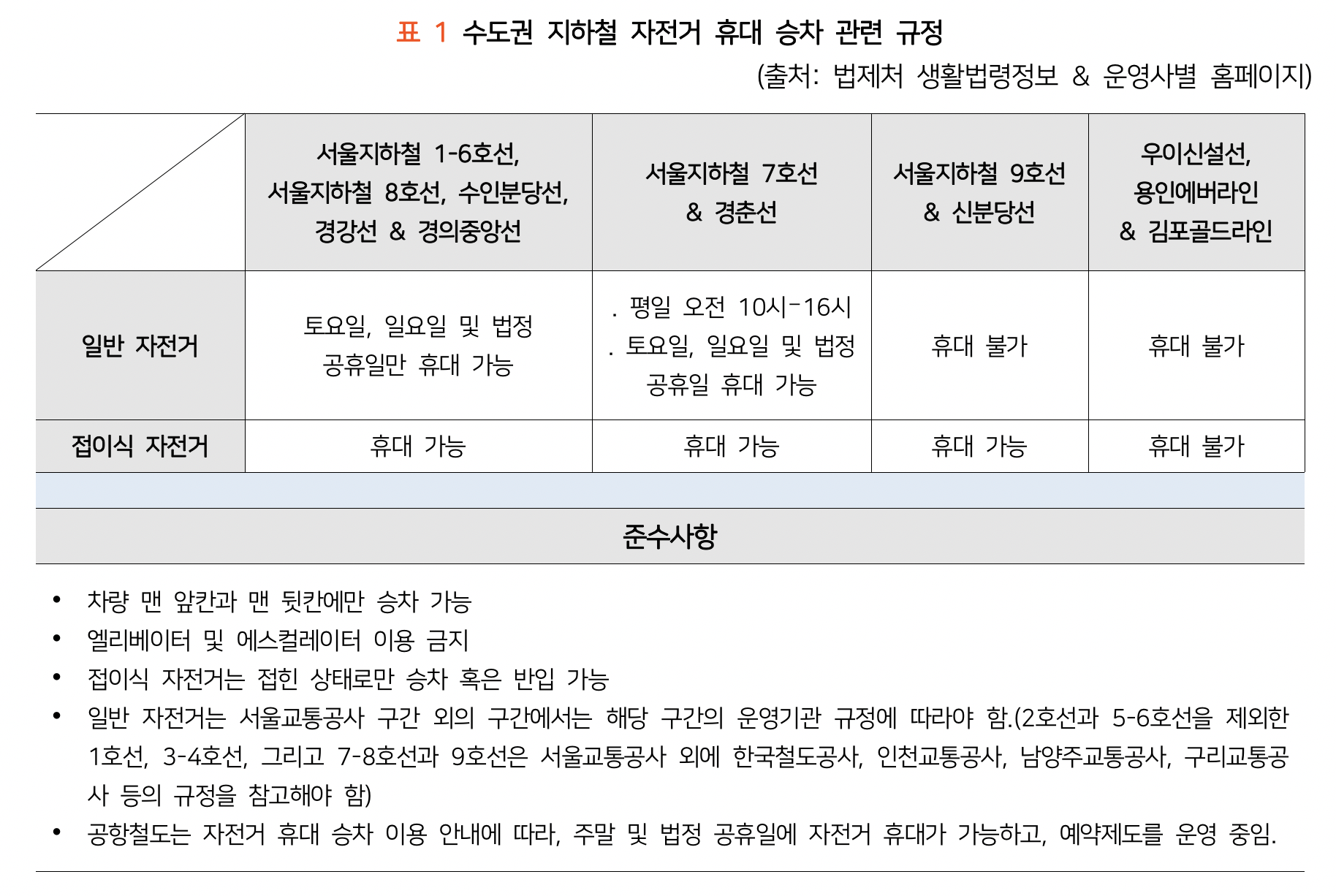
(Source: Korea Legislation Research Institute – Living Law Information & Official Websites of Operating Companies)
You can also load your bicycle onto a train to travel to your destination. A travel agency specializing in bicycle tours, called “Travel Workshop,” operates bicycle travel packages using the Ecorail service in partnership with Korail. The Ecorail trains are specially designed for bicycle travelers, consisting of both bicycle storage cars and regular passenger cars. Although it is unfortunate that these trains do not run regularly on demand for individual travelers, for group bookings, institutional trips, or planned travel events, organizers can request Ecorail service through Travel Workshop. Afterward, Travel Workshop negotiates with Korail to operate routes that fit the desired travel destinations. The Ecorail train consists of a locomotive, a power car, four regular passenger cars similar in size to the Saemaeul train cars, and four bicycle storage cars. Each storage car can accommodate about 61 bicycles, including regular bikes, mountain bikes, and electric bikes. Ecorail trains operate on all domestic rail lines accessible from Seoul Station, except for KTX-only stations.
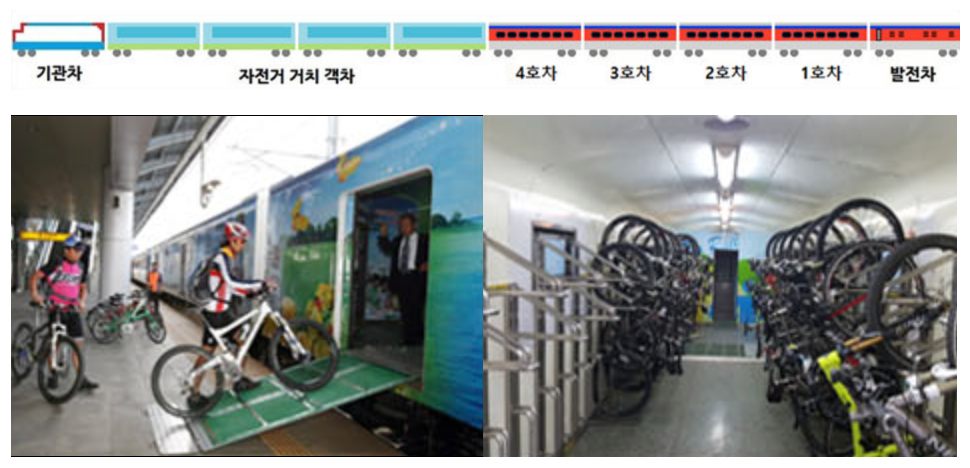
<Figure 5> Ecorail: Train Car Layout and Bicycle Storage Car
(Source: Travel Workshop)
Domestic bicycle travel can also include air travel as a means of transportation. Virtu Company, a bicycle travel startup, operates a packaging service called “Roundel Service” for air transport of bicycles. Known as the “Greenpack” service, it allows bicycle travelers to rent bike cases at their departure airport and return them at their arrival airport. Since October 2023, the Greenpack service has been operating at Gimpo, Gimhae, Cheongju, Daegu, and Jeju airports through each airport’s luggage storage facilities on a consignment basis. Starting from November 2024, the service was also launched at Incheon International Airport. However, for international bicycle travelers, the Greenpack service does not include the return option at the arrival airport.
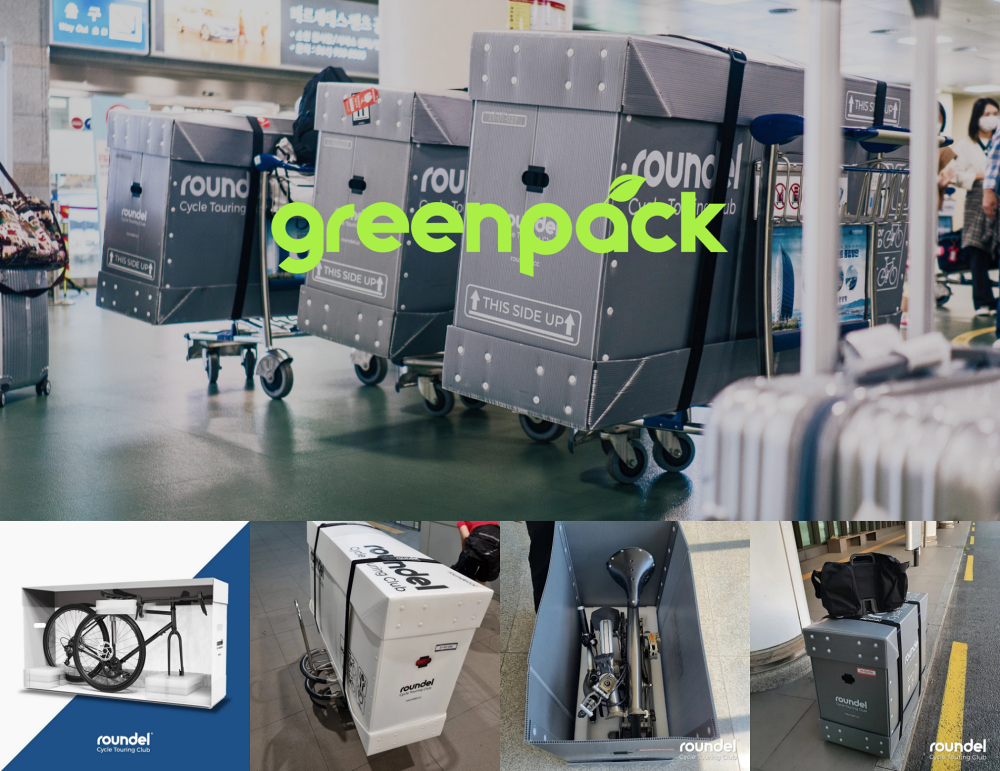
<Figure 6> Bicycle Air Transport Packaging: Greenpack Service
(Source: Roundel Official Website & Instagram)
Meanwhile, bicycle travel does not necessarily require using a personally owned bike. After arriving at the destination, travelers can also consider using mobility-based travel or services provided by shared platforms. Local shared platforms, in particular, expand the range of sustainable travel options by simultaneously promoting regional tourism and reducing carbon emissions.
TRAVIT is an electric bicycle sharing platform launched in 2022 by Openit, a company specializing in core technology for tourism-oriented mobility AR glasses (augmented reality glasses). It was started in Chuncheon, a city with bicycle-friendly travel conditions, in collaboration with the Chuncheon City Tourism Association and the Gangwon Information & Culture Industry Promotion Agency. TRAVIT aims to promote carbon-zero travel and spread a sustainable travel culture by enabling travelers to continue their journeys by bike in areas where vehicle access is limited—such as remote tourist spots or disconnected trail sections—and by providing services that support both the local economy and environment while staying in main tourist regions. The name “TRAVIT” combines “Travel” and “IT (Information Technology)” to convey the idea of traveling freely like a rabbit, overcoming the limitations of public transportation or cars. This concept is reflected in their custom-built bikes, which feature wide tires for smooth riding on unpaved roads, the option to attach travel carriers, and accommodations for pets to ride along. Additionally, TRAVIT offers a “TRAVIT Pass” to help users conveniently access other transportation modes like public transit. According to a 2024 service satisfaction survey, 92% of TRAVIT users reported being very satisfied with the service, and 100% expressed intentions to use it again.

<Figure 7> TRAVIT Center and TRAVIT Bikes in Chuncheon
(Source: TRAVIT Official Blog)
WHERE to STAY: where can you stay overnight during a bicycle trip?
When planning a bike trip that lasts more than a day, one of the biggest concerns is accommodation. Most lodging facilities, including hotels, either lack bike racks or do not allow bike storage at all, making it crucial to find accommodations that can safely store bicycles from the very beginning of trip planning. Roundel, a company providing bicycle air transport services, helps ease this concern for travelers biking around Jeju Island. Roundel partners with about 30 accommodations across Jeju, displaying Roundel-certified plaques or wind banners, offering secure bike storage spaces and racks within the facilities, and even providing shared bike tools to make the trip more convenient for cyclists.

<Figure 8> Safe Accommodation Certified by Roundel
(Source: Roundel Official Website & Instagram)
Since 2021, WIKE has been planning and operating Riders Camp in partnership with various campsites across South Korea. For travelers carrying camping equipment on their bicycles, WIKE provides camping spots within the campsites, while for those without camping gear, it offers rental camping supplies at designated camping zones to help secure accommodations. Some of the campsites collaborating with WIKE to provide camping accommodations for bicycle travelers include Red House Campground in Yangpyeong, Yaho Campground in Ganghwa Island, and Osiano Campground in Haenam.
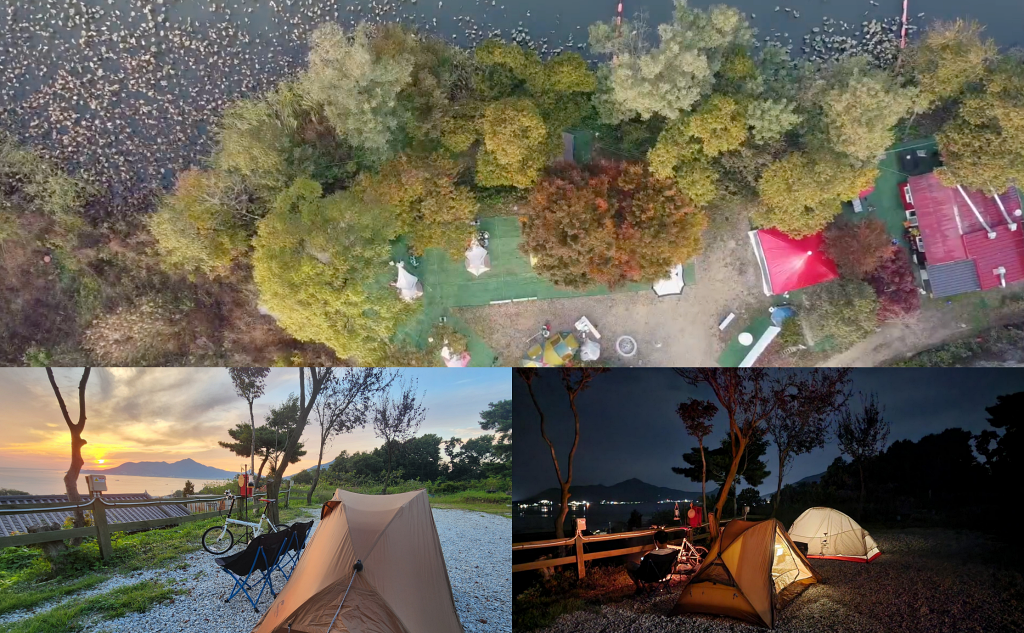
(Source: WIKE Official Website)
SOS: can i get maintenance services during a bicycle trip?
Samchuly Bicycle, a leading bicycle company in South Korea, selected three keywords—‘M.V.P’—to summarize the domestic bicycle industry in 2023. These represent trends showing an increase in users’ adventurous and challenge-seeking travel tendencies (Venture), a growing diversity in individual purposes and ways of using bicycles such as leisure, travel, commuting, and delivery (Personality), and a rising awareness of the importance of safety and maintenance (Maintenance).
Bicycle users, especially those planning bike trips, have traditionally carried basic repair tools to perform their own maintenance or visited nearby repair shops and facilities during their travels to get their bikes serviced. Even today, some bike travelers prefer this approach. However, not every cyclist possesses the knowledge or carries the necessary tools for repairs when embarking on a trip. In fact, some travelers find it difficult even to locate a bike shop capable of repairs when their bicycle breaks down during a journey. In response to the increased demand for bicycle travel following the pandemic, it is encouraging to see the emergence of services that provide convenient and relatively easy solutions to maintenance issues.
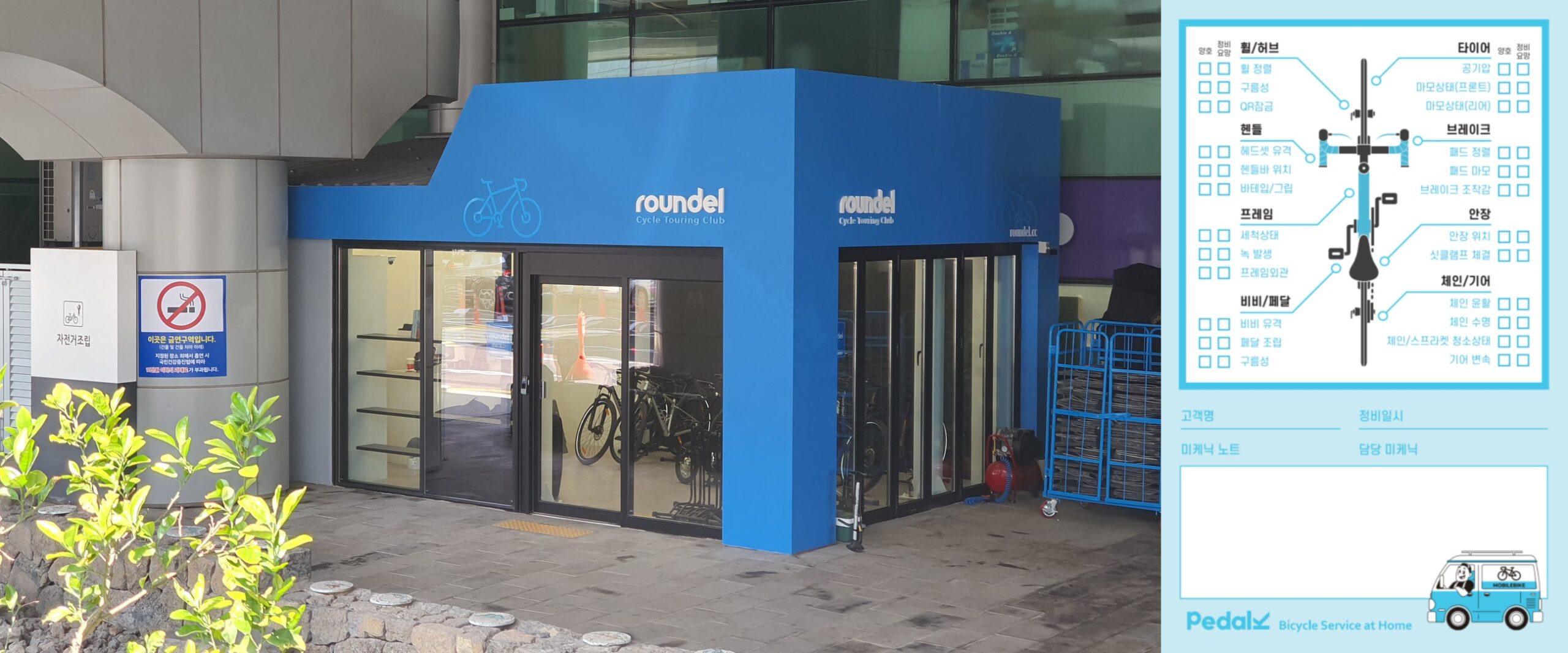
(Source: Roundel Official Website & PedalCheck Official Website)
WIKE’s “Pedal Check” is a service with the motto of “mobile bicycle maintenance,” designed to help cyclists enjoy bicycle camping safely and in various regions by providing maintenance support. Pedal Check started in 2020 as a bicycle rewards app but has since evolved into a comprehensive mobile bike management app that builds a bicycle network and offers a wide range of services—from free inspections and maintenance reservations and payments to maintenance history management and on-site repair brokerage. Utilizing IT technology and a mobility maintenance network, Pedal Check primarily provides on-site repair for regular bicycles and e-mobility devices, as well as B2B secure assembly and delivery. In particular, for on-site repairs, Pedal Check connects customers with local expert mechanics, enabling repairs to be carried out wherever the customer is. It collaborates with the Korea Bicycle Maintenance Union (KBMU) to expand its network nationwide. As of September 2024, the service is available across Seoul, Incheon, and most areas of Gyeonggi Province (except for some regions). The service also offers tire and tube replacements, gear and brake adjustments, bike cleaning, advanced maintenance, assembly of online-purchased bikes, and pickup services. Meanwhile, Rondel, a bicycle packing and transportation service, currently operates a Rondel Station in Jeju Island, offering bike rentals, maintenance, and gear purchases within its system.
Footnote
- If you use a bicycle instead of a car just once a day, you can reduce your carbon footprint by approximately 0.5 tons over the course of a year. Bicycles are an excellent low-carbon mode of transportation because they produce no direct carbon emissions during use.
- In October 2024, the Low-Carbon Travel Week hosted by the Ministry of Culture, Sports and Tourism and the Korea Tourism Organization featured various walking and cycling challenge campaigns, including the Korea Dulle-gil National Trail Challenge, the 45 Recommended Course Certification Campaign, the 60 Free Cycling Course Challenge Campaign, and walking and cycling trips linked with the low-carbon Eco Rail train.
- The domestic walking travel platform ‘Durunubi’ has provided information on various trails and travel routes nationwide. However, since November 21, 2022, it has discontinued its information services for ‘general paths/bicycle paths’, except for the Korea Dulle-gil trails (Haeparang-gil, Namporang-gil, and Seohaerang-gil).
References
- Manfred Lenzen et al. (2018) The carbon footprint of global tourism, Nature Climate Change, Vol. 8, pp. 522–528.
- Sustainable Travel International (n.d.) Carbon Footprint of Tourism: How Travel Contributes to the Climate Emergency.
- University of Oxford: News (2021.02.02.) Get on your bike: Active transport makes a significant impact on carbon emissions.
- Ya-Yen Sun et al. (2024) Drivers of global tourism carbon emissions, Nature Communications, Vol. 15, Article number: 10384.
- 라운델 공식홈페이지.
- 문화체육관광부: 보도자료 (2024.10.27.) 6.25 전적지 등 네 번째 자전거 순례, 지역관광 활성화 모색 .
- 법제처 생활법령정보: 자전거 운전자 – 대중교통 이용하기.
- 여행공방 공식 홈페이지.
- 연합뉴스 (2024.07.15.) 더스윙, 일반자전거 이용 한 달새 3배로…’N분도시’ 조성 노력.
- 와이크 공식 홈페이지 및 인스타그램.
- 코레일: 에코레일.
- 트래빗 공식 홈페이지 및 블로그.
- 한국관광공사: 두루누비.
- 한국문화관광연구원 (n.d.) 관광지식정보시스템: 국민여행조사.










